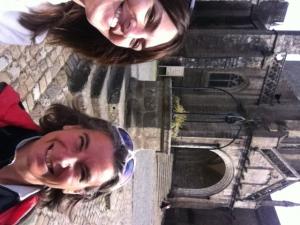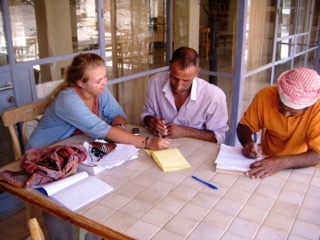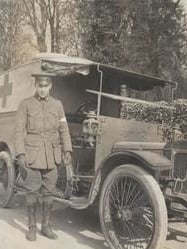World War I Volunteers And Beyond
Happy Veteran's Day!

Last night I watched Fly Boys, a movie about U.S. volunteers traveling to France in 1914 to take part in World War I. It’s a true story about the legendary Lafayette Escadrille, and tells the tale of America’s first fighter pilots. The Lafayette Escadrille was a squadron (or Escadrille in French) of volunteer Americans established for active fighter pilot service on the Western Front. Fittingly, the squadron was named after the Frenchman who served alongside George Washington.
Watching the movie, I slowly recalled that the U.S. did not even enter World War I until 1917. For three years, American volunteers poured into France. Another volunteer organization operating in France during World War I was AFS—The American Field Service. When you hear “AFS” today, you may know them as an international youth exchange organization, which is still active in more than 75 countries and is one of the largest volunteer based organization in the world…second only to the American Red Cross. Back in World War I, you would have known them as volunteer ambulance drivers, recruited from colleges and universities around the U.S. to drive Ford Model T ambulances along the front lines, picking up dead and wounded soldiers. One AFS driver wrote, “Though I did not want to kill I was willing to take a chance of being killed.”
Another volunteer organization operating in France during World War I was AFS—The American Field Service. When you hear “AFS” today, you may know them as an international youth exchange organization, which is still active in more than 75 countries and is one of the largest volunteer based organization in the world…second only to the American Red Cross. Back in World War I, you would have known them as volunteer ambulance drivers, recruited from colleges and universities around the U.S. to drive Ford Model T ambulances along the front lines, picking up dead and wounded soldiers. One AFS driver wrote, “Though I did not want to kill I was willing to take a chance of being killed.”
Our global volunteer program here at GeoVisions has its roots in The American Field Service—the volunteer ambulance corps. In fact, all global volunteer programs operating today owe gratitude to the AFS volunteer ambulance drivers in World War I.
I am lucky enough to have interviewed many former AFS volunteer drivers during my service there in 1992 and 1993. Headquartered at an ancient château at 21 rue Raynouard in the Parisian suburb of Passy, the American Field Service had more than 800 volunteer ambulance drivers.
If you walk with me today in Passy, we would find an exclusive area of Paris, located in the 15th arrondissement on the Right Bank. It is traditionally home to many of the city's wealthiest residents. For Americans, we know that area best for being the home of Benjamin Franklin for the nine years that he lived in France during the American Revolutionary War. Today at GeoVisions (and other such organizations), when we recruit college students to study or volunteer abroad, we go to colleges and put up posters and speak with students and their study abroad advisors. From 1914-1917 the AFS actively recruited its drivers from the campuses of American colleges and universities with individual ambulance units made up exclusively of drivers from particular universities. There were Harvard units and Yale units among the hundreds of others, and they all worked without pay. Ambulance driving required the volunteers to serve under extremely dangerous missions on the Western Front. In World War I alone there were 151 drivers with the AFS who were killed (21 of them from Harvard) and a number of others earned the Croix de Guerre and the Legion of Honor for their heroic actions.
Today at GeoVisions (and other such organizations), when we recruit college students to study or volunteer abroad, we go to colleges and put up posters and speak with students and their study abroad advisors. From 1914-1917 the AFS actively recruited its drivers from the campuses of American colleges and universities with individual ambulance units made up exclusively of drivers from particular universities. There were Harvard units and Yale units among the hundreds of others, and they all worked without pay. Ambulance driving required the volunteers to serve under extremely dangerous missions on the Western Front. In World War I alone there were 151 drivers with the AFS who were killed (21 of them from Harvard) and a number of others earned the Croix de Guerre and the Legion of Honor for their heroic actions.
Some of the AFS ambulance drivers who later became famous around the world were Dashiell Hammett, Ernest Hemingway, Archibald MacLeish, Sidney Howard, Maurice Ravel, Walt Disney and Ray Kroc. And as I mention Hemingway, I am reminded that the primary character in A Farewell to Arms, like Hemingway himself, is wounded while serving as an ambulance driver in Italy and falls in love with his nurse in the hospital. Several AFS drivers I interviewed met their future spouses in hospitals around Europe.
What would bring these young volunteers to the Front in World War I? The automobile was so new that many of the young men had to learn to drive before they could serve. Adventure, patriotism, doing what's right, signing up because others in the same school class signed up, and wanting to participate in what was of significance to the world at the time were all reasons for joining.
Here at GeoVisions, we hear many of the same reasons our volunteers want to help in Thailand, Vietnam, China, Peru, Argentina, Costa Rica, Namibia and other countries.
As soon as World War I was over, returning drivers established homestay exchanges between American and Frenchudents hoping the cultural awareness would put an end to war. But, when World War II broke out, AFS again provided ambulance service in France and North Africa.
I am proud to have been a very small part of the AFS and to have had the honor of meeting and interviewing two of the World War I and several of the World War II drivers. You can imagine how proud I am of what we are doing at GeoVisions International with our global work and service programs. But nothing makes me more proud than to see our volunteers abroad, walking the talk, rolling up their sleeves and making such a positive difference in the world.
One of the first published accounts of the American Field Service was written by Leslie Buswell in 1916 in a 155-page book…more a collection of letters sent from France. I have included a photograph of Mr. Buswell below. Quoting from Mr. Buswell’s book is a fitting ending to my monthly letter.
“So the days pass ----Now, with the evening, comes, as
often, a grateful time of stillness. I like to watch from my window the shadows lengthen as the sun leaves to them their part. A little later, when they have wholly obscured all detail, man will perhaps furtively begin some move to make the night unlovely --- but for the moment there is rest.”
“Sometiudents hoping the cultural awareness would put an end to war. But, when World War II broke out, AFS again provided ambulance service in France and North Africa.
I am proud to have been a very small part of the AFS and to have had the honor of meeting and interviewing two of the World War I and several of the World War II drivers. You can imagine how proud I am of what we are doing at GeoVisions International with our global work and service programs. But nothing makes me more proud than to see our volunteers abroad, walking the talk, rolling up their sleeves and making such a positive difference in the world.
One of the first published accounts of the American Field Service was written by Leslie Buswell in 1916 in a 155-page book…more a collection of letters sent from France. I have included a photograph of Mr. Buswell below. Quoting from Mr. Buswell’s book is a fitting ending to my monthly letter.
“So the days pass ----Now, with the evening, comes, as often, a grateful time of stillness. I like to watch from my window the shadows lengthen as the sun leaves to them their part. A little later, when they have wholly obscured all detail, man will perhaps furtively begin some move to make the night unlovely --- but for the moment there is rest.”
I am proud to have been a very small part of the AFS and to have had the honor of meeting and interviewing two of the World War I and several of the World War II drivers. You can imagine how proud I am of what we are doing at GeoVisions International with our global work and service programs. But nothing makes me more proud than to see our volunteers abroad, walking the talk, rolling up their sleeves and making such a positive difference in the world.
One of the first published accounts of the American Field Service was written by Leslie Buswell in 1916 in a 155-page book…more a collection of letters sent from France. I have included a photograph of Mr. Buswell below. Quoting from Mr. Buswell’s book is a fitting ending to my monthly letter.
“So the days pass ----Now, with the evening, comes, as often, a grateful time of stillness. I like to watch from my window the shadows lengthen as the sun leaves to them their part. A little later, when they have wholly obscured all detail, man will perhaps furtively begin some move to make the night unlovely --- but for the moment there is rest.”
“Someti
mes --- when the day's work is done --- and there is a quiet hour here, I can understand now the lure of peace --- and so I am doubly grateful that those of you for whom I care most have chosen to work --- rather than to forget the struggle here. When I come back to you some day, we shall feel a greater peace and sympathy for knowing that with the same eagerness, if in different ways, we have tried to serve and to save those men whose heroism makes our best effort seem a very small thing.”
Leslie Buswell, 1916. With the American Field Service in France.
Inspire the world, Inspire Yourself,
 Read More
Read More

This Blog post (and the one that follows tomorrow) was written by Steve Weddle, Founder and Chief Executive Officer of Volunteer Forever. Steve...

Hello, my name is Angelique!

1 min read
A normal summer for me throughout high school and college never involved long, lazy days at the beach or weekend trips to the Appalachian Mountains....
 Read More
Read More

As the Executive Director of GeoVisions, founders of The Conversation Corps, I'm able to see all the good aspects of a program as well as those that...